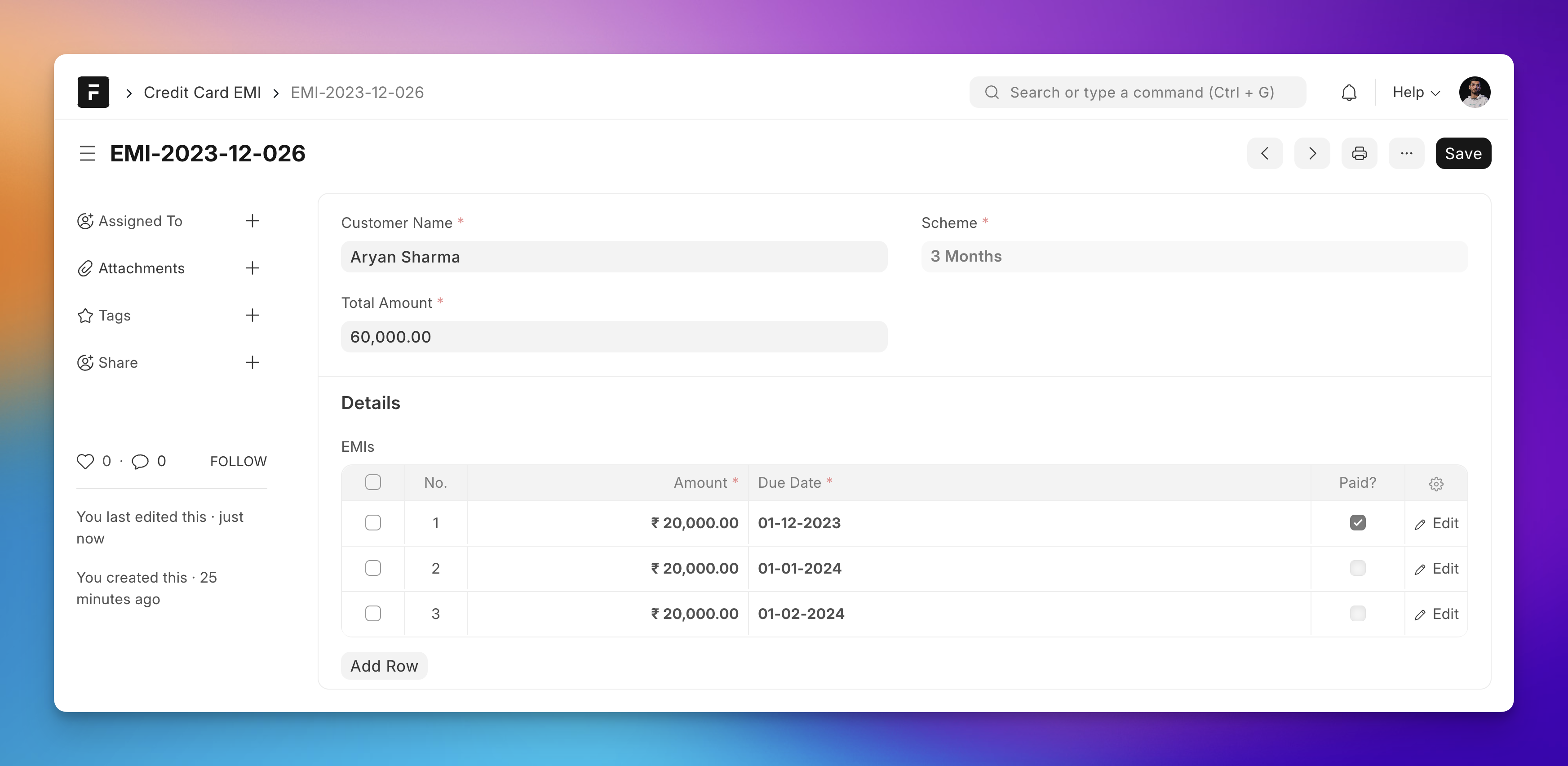Child Table Data in Columns
Introduction
An example of a report that shows the child table values in a single row with the parent data. Also, columns can be dynamic.
Use Case
Suppose we have a demo DocType named Credit Card EMI which has the following fields:
- Customer Name
- Total Amount
- Scheme: 3/6/12 Months
- EMIs: Child table with EMIs based on the scheme
Here is a screenshot showing the form view:

The Report
We want to create a report that has this EMIs in different columns, like shown below:

The Script
import frappe
# maximum number of EMIs for a Credit Card EMI# case when EMI is paid in 1 yearNUM_MAX_EMI = 12
def execute(filters=None): columns = get_columns() data = get_data(filters)
return columns, data
def get_columns(): columns = [ { "label": "Credit Card EMI", "fieldname": "credit_card_emi", "fieldtype": "Link", "options": "Credit Card EMI", }, { "label": "Customer Name", "fieldname": "customer_name", "fieldtype": "Data", }, { "label": "Scheme", "fieldname": "scheme", "fieldtype": "Data", }, ]
# 1 column for each EMI for i in range(1, NUM_MAX_EMI + 1): columns.append( { "label": "EMI {}".format(i), "fieldname": "emi_{}".format(i), "fieldtype": "Data", "options": "EMI", } )
return columns
def get_data(filters=None): data = []
credit_card_emis = frappe.get_all( "Credit Card EMI", fields=["name", "customer_name", "scheme"] )
for credit_card_emi in credit_card_emis: row = { "credit_card_emi": credit_card_emi.name, "customer_name": credit_card_emi.customer_name, "scheme": credit_card_emi.scheme, }
# get all EMIs (child items) for the Credit Card EMI emis = frappe.get_all( "EMI", fields=["amount", "due_date", "paid", "idx"], filters={"parent": credit_card_emi.name}, )
# e.g. emi_1 = 1000, emi_2 = 2000, emi_3 = 3000, etc. for emi in emis: row["emi_{}".format(emi.idx)] = format_currency(emi.amount)
# set rest of the EMI columns to "-" for i in range(1, MAX_EMI + 1): if "emi_{}".format(i) not in row: row["emi_{}".format(i)] = "-"
data.append(row)
return data
def format_currency(value, currency="INR"): return frappe.format_value(value, df={"fieldtype": "Currency"}, currency=currency)Optimizing The Data Fetching
If you observe the get_data() method, you will see we are calling the frappe.get_all method to get child items for each Credit Card EMI doc, which means 1 DB call per document (O(n) in computer sciency terms).
We can use the Query Builder to reduce this to just one database call (query is highlighted):
def get_data_with_qb(filters=None): data = [] credit_card_emi = frappe.qb.DocType("Credit Card EMI") emi = frappe.qb.DocType("EMI")
query = ( frappe.qb.from_(emi) .join(credit_card_emi) .on(emi.parent == credit_card_emi.name) .select( credit_card_emi.name.as_("credit_card_emi"), credit_card_emi.customer_name, credit_card_emi.scheme, emi.amount, emi.due_date, emi.paid, emi.idx, ) )
emi_items = query.run(as_dict=True)
# group EMI items by Credit Card EMI credit_card_emi_items = {} for emi_item in emi_items: credit_card_emi_items.setdefault(emi_item.credit_card_emi, []).append(emi_item)
# create a row for each Credit Card EMI for credit_card_emi, emi_items in credit_card_emi_items.items(): row = { "credit_card_emi": credit_card_emi, "customer_name": emi_items[0].customer_name, "scheme": emi_items[0].scheme, }
# create a column for each EMI for emi_item in emi_items: row["emi_{}".format(emi_item.idx)] = format_currency(emi_item.amount)
# set rest of the EMI columns to "-" for i in range(1, MAX_EMI + 1): if "emi_{}".format(i) not in row: row["emi_{}".format(i)] = "-"
data.append(row)
return dataWe had to add more data processing on the Python side though.

